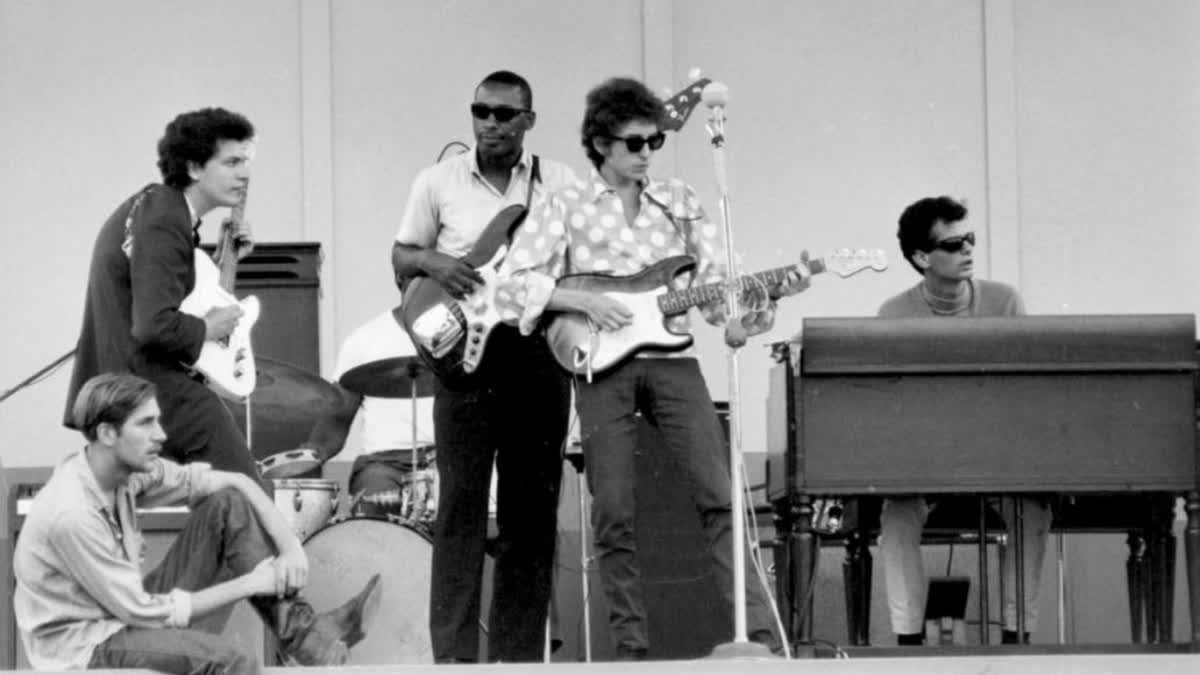Hollywood actor Timothée Chalamet is singing Bob Dylan’s Subterranean Homesick Blues in a new teaser for upcoming biopic Complete Unknown. The actor is voicing the politically charged lyrics with the same biting irony as Dylan did back in 1965. He is a spitting image of the Nobel prize-winning American singer-songwriter in the teaser and trailer.
As Timothée Chalamet prepares to portray Dylan, audiences will get a glimpse of this moment that reshaped an entire genre. Complete Unknown is based on a historic moment in a young Dylan's life (it also inspired author Elijah Wald's book Dylan Goes Electric!).
When Dylan Went Electric
In 1965, Bob Dylan’s decision to go electric on stage was a moment that cracked open the world of popular music. It happened on 25th July at the Newport Folk Festival in the US. That music festival prized its acoustic purity and folk values, where guitars were always unplugged and voices unadorned. But that summer, Dylan showed up with a Stratocaster and plugged into a sound that would redefine rebellion in America.
Dylan stepped out before an audience expecting the usual unamplified sound. Instead, what they got was a blast of distortion, an amplified set that shattered the intimacy of folk with a brashness that seemed almost violent. Newport wasn’t ready for Dylan’s Fender Stratocaster. To his fans, it sounded like betrayal.
Moment of Impact
To understand what Dylan’s electric performance meant, we have to understand what folk music represented at the time. Folk music was about identity, community and politics for white Americans. With his songs about social justice and war, Dylan was the poet of that community. Folk fans wanted his lyrics to be unfiltered, without interference from loud amplifiers or electric beats.
But Dylan had already outgrown those constraints. His music was moving toward something harder to define, a fusion of folk’s introspection with the louder, brasher energy of rock. His 1965 hit Like a Rolling Stone had already hinted at this evolution. With its snarling vocals and electric edge, it was unlike anything Dylan had produced before. Critics and fans would later call it one of the greatest rock songs of all time.
On that July evening in Newport, Dylan took the stage, backed by guitarist Mike Bloomfield and organist Al Kooper. The first notes of Maggie’s Farm sent a jolt through the crowd. The response was immediate. Some booed, some cheered. Folk purists were horrified. To them, Dylan’s electric guitar was an assault on the sanctity of folk.
The Ripple Effect
Dylan’s decision to go electric sparked a divide that rippled across the music world. Many fans felt he had “sold out,” trading his folk roots for mainstream appeal. What these fans saw as a betrayal, others saw as liberation. Dylan’s electric shift opened up possibilities that hadn’t existed before. Folk-rock was born, and soon artists like The Byrds, Joan Baez, and Simon & Garfunkel were blending acoustic tradition with rock.
The effect was seismic. The Byrds would go on to release Mr. Tambourine Manlater that year, bringing Dylan’s lyrics into a new, electric context. By 1966, folk-rock was a genre of its own, and Dylan had inspired a wave of musicians who saw rock not as a replacement for folk but as an extension of its ideals.
Dylan’s move also broke down genre barriers. He showed that music didn’t have to fit into neat categories. Artists no longer had to choose between being folk singers or rockstars. They could be both. Joni Mitchell, Neil Young, and even The Beatles would go on to explore these intersections, merging genres in ways that continue to influence music today.
Going Electric Was More Than Just A Choice
What Dylan did at Newport wasn’t simply about amplifying his sound. It was a rejection of the puritanism that folk music demanded. Folk, with its emphasis on the acoustic and the “authentic” had become a bit like a museum piece. For Dylan, staying confined to that world meant ignoring his own artistic growth.
Actor Timothee Chalament (left) is a dead ringer for artist Bob Dylan (right) (ETV Bharat) He understood that the world was changing. The civil rights movement was at its height, the Vietnam War was escalating, and America was in a state of upheaval. He knew that the idealism of folk music, while powerful, wasn’t enough to capture the dissonance of that era. The amplified sound of rock offered a more visceral way to channel those anxieties. His choice to go electric was a response to a world that was itself becoming more complicated and polarised.
Dylan’s Legacy In Today’s Music
The artist's Newport performance is remembered as one of the most pivotal moments in music history. It marked a turning point, not just for Dylan but for popular music as a whole. His decision to go electric redefined what it meant to be a “protest singer,” proving that you didn’t have to stick to tradition to make a statement. In the decades since, musicians from rocker Bruce Springsteen to rapper Kendrick Lamar have channelled Dylan’s spirit of defiance, embracing new sounds to reflect the times.
Read more:
- Interview | The Connection With The Audience In India Is Special: Robert Randolph, American Blues Musician
- From Hanumankind To Munawar Faruqui And Raftaar, Top 5 Multitasking Rappers From India Who Have Side Hustles
- Punch The Clock Day: A Playlist And A Nod To Workplace History
